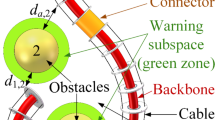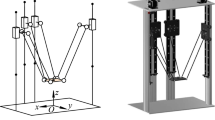Abstract
In this paper, a new cable-based parallel robot is introduced. In this robot, the cables are used to not only actuate the end-effector but apply the necessary kinematic constrains to provide three pure translational degrees of freedom. In order to maintain tension in the cables, a collapsible element called “spine” is used between the end-effector and the robot’s base. The kinematic analysis of this robot is similar to that of a rigid link parallel manipulator as long as the cables are in tension. The rigidity of this robot which corresponds to having all cables in tension is studied thoroughly and it is proved that a single spine with a finite force is sufficient to guarantee rigidity for any external load at any position of the workspace.
Similar content being viewed by others
References
Barrete, G. and Gosselin, C.M., ‘Kinematic analysis and design of planar parallel mechanisms actuated with cables’, in Proceeding of ASME Desing Engineering Technical Conferences, 2000, 391–399.
Landsberger, S.E. and Sheridan, T.B., ‘A minimal, minimal linkage: The tension compression parallel link manipulator’, in Proceedings of IMACS/SICE International Symposium on Robotics, Mechatronics and Manufacturing Systems, 1993, 81–88.
Albus, J., Bostelman, R., and Dagalakis, N., ‘The nist robocrane’, Journal of Robotic Systems 10, 1993, 709–724.
Kawamura, S., Choe, W., Tanak, S., and Pandian, S.R., ‘Development of an ultrahigh speed robot falcon usign wire driven systems’, IEEE International Conference on Robotics and Automation 1995, 215–220.
Gough, V.E. and Whitehall, S.G., ‘Universal tyre test machine’, in Proceedings of 9th International Technical Conference F.I.S.I.T.A, 1962, 117–135.
Kawamura, S., Kino, H., and Choe, W., ‘High-seed manipulation by using parallel wire driven robots’, Robotica 18, 2000, 13–21.
Landsberger, S.E. and Shanmugasundram, P., ‘Workspace of a parallel link crane’, in Proceedings of IMACS/SICE International Symposium on Robotics, Mechatronics and Manufacturing Systems, 1992, 479–486.
Ming, A. and Higuchi, T., ‘Study on multiple degree-of-freedom positioning mecha-nism using wires (part1)’, International Journal of Japan Society of Precision Engineering 28, 1994, 131–138.
Takeda, Y. and Funabashi, H., ‘Kinematic synthesis of spatial in-parallel wire-driven mechanism with six degrees of freedom with high force transmissibility’, in Proceeding of ASME 2000 Design Engineering Technical Conference, 2000, 383–388.
Khajepour, A., Behzadipour, S., and Dekker, R., ‘Light weight parallel manipulators using active/passive cables’, United States Prvisional Patent No. 60/394272, 2002.
Tsai, L.-W., Kinematics of a three dof platform with three extensible limbs, in Recent Advances in Robot Kinematics, Lenarcic, J. and Parenti-Castelli, V. (eds.), Kluwer Academic Publishers, Dordrecht, 1996, 401–410.
Author information
Authors and Affiliations
Corresponding author
Rights and permissions
About this article
Cite this article
Behzadipour, S., Khajepour, A. A New Cable-Based Parallel Robot with Three Degrees of Freedom. Multibody Syst Dyn 13, 371–383 (2005). https://doi.org/10.1007/s11044-005-3985-6
Received:
Accepted:
Issue Date:
DOI: https://doi.org/10.1007/s11044-005-3985-6




